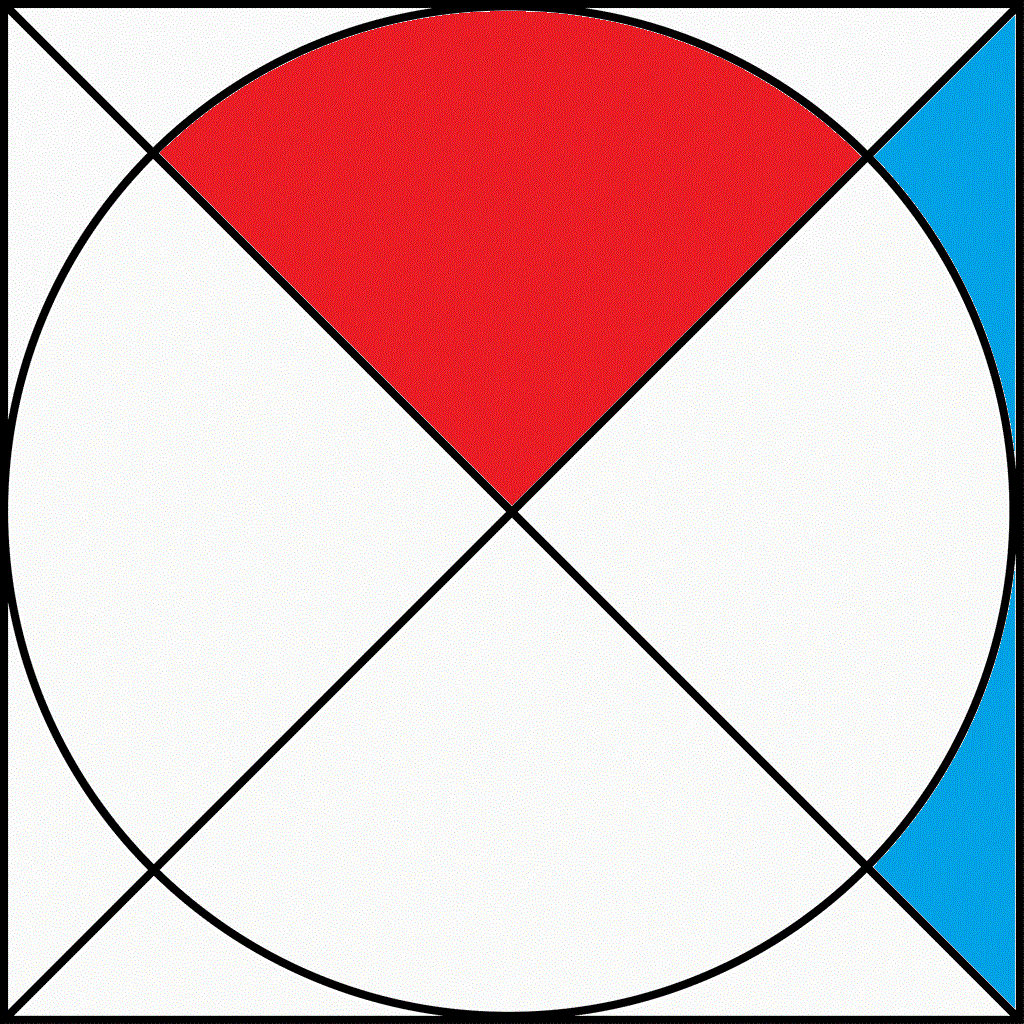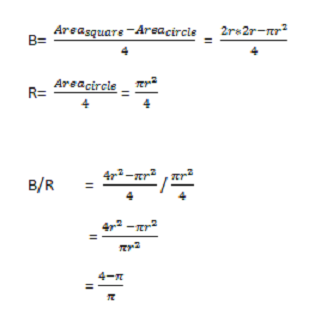Perfect fit
 Consider the image above. Let
R
and
B
denote the area of the red section and blue section respectively. If the area of the square is
1
0
2
4
cm
2
, find
R
B
. Give your answer to 3 decimal places.
Consider the image above. Let
R
and
B
denote the area of the red section and blue section respectively. If the area of the square is
1
0
2
4
cm
2
, find
R
B
. Give your answer to 3 decimal places.
Note - The image is up to scale.
The answer is 0.273.
This section requires Javascript.
You are seeing this because something didn't load right. We suggest you, (a) try
refreshing the page, (b) enabling javascript if it is disabled on your browser and,
finally, (c)
loading the
non-javascript version of this page
. We're sorry about the hassle.
5 solutions
Discussions for this problem are now closed
the area of fig=4B+4R=1024 B+R=256 R=256-B AREA OF FIG=X^2=1026 X=32 r=16 R=.25 22/7 16*16=201.14 B=256-R=256-201.14=54.85 B/R=54.85/201.14=0.272
guys i explain to me how you got the answer
I've added a bit more detail to the solution to make it much clearer. Does this help?
The actual area of the square doesn't matter because it is a ratio problem. You'll see that r cancels out:

diameterof the cercle √1024 = 32 So r = 16
area of the circle =(16)^2 pi = 256 pi
R= (256/4) pi = 64 pi = 200.96
B = (1024 - 803.84)/4 =(220.16 / 4 ) = 55.04
B/R = 0.2738854
First you need to find the area of the circle to do this you need the radius. To find the radius you square root the area of the square to get the length of the square
1 0 2 4 = 3 2
Since the length of the square is the same as the diameter of the circle you just need to halve it to find the radius.
2 3 2 = 1 6
So r = 1 6
Next we need to find the area of the sector in the circle (the red bit). To do this we first need to find the total area of the circle.
a = π r 2
In terms of π this gives us a = 2 5 6 π c m 2
Since the image is to scale the red sector has an angle of 9 0 ∘ . So to find the sector we use this formula
a s e c t o r = 3 6 0 a ⋅ A n g l e ∘
So the area of the sector is
a s e c t o r = 3 6 0 2 5 6 π ⋅ 9 0 ∘ = 6 4 π c m 2
R = 6 4 π c m 2
We now have the red area but what about the blue?
The blue area is (since the image is to scale) about one quarter of the area left when you subtract the area of the circle from the area of the square so
B = 4 1 0 2 4 c m 2 − 2 5 6 π c m 2 ≈ 4 2 1 9 . 7 5 2 c m 2 ≈ 5 4 . 9 3 8 c m 2
So
R B ≈ 2 5 6 π c m 2 5 4 . 9 3 8 c m 2 ≈ 0 . 2 7 3
To calculate this ratio, the area of the square is irrelevant. Let “X” be the radios of the circle. So width and height of the square is 2 x X. Area of the circle = πX^2 Area of the square = (2X)2 = 4X2
Area of R = πX^2 / 4
Area of B = (4X2 / 4) - πX^2 / 4 = (4X2 - πX^2) / 4
B / R = (4X2 - πX^2) / (4 (πX^2 / 4)) = (4X2 - πX^2) / πX^2 = (4 – π) / π
Assuming π = 22/ 7,
B / R = (4 * 7) / 22 – 1 = 28 / 22 – 1 = 6 / 22
Answer: B / R = 3 / 11
It didn't mention that we assume π = 7 2 2 so we shouldn't assume it, but good job nonetheless!
The size of the square is not important, so I will scale the square with a side length of 2.
Observe that 4 times of the red area is the circle, and 4 times of the blue area is the square minus the circle.
Thus the ratio is A c i r c l e A s q u a r e − A c i r c l e for my values, we get π 4 − π .